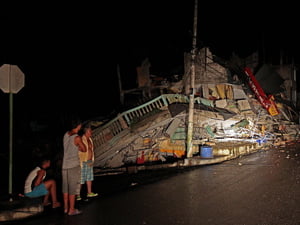
The 7.8-magnitude quake struck the north-western part of the country at 7:58 pm (2358 GMT) Saturday, the US Geological Survey said. Its epicentre was 20 kilometres underground and about 170 kilometres north-west of the capital Quito.
Vice President Jorge Glas said Sunday the death toll had risen to 77 with at least 588 people injured.
The government has deployed about 10,000 soldiers and 3,500 police officers to the affected areas, Glas tweeted.
Workers from other countries including Mexico and Colombia are also on their way to the country to support rescue efforts.
Glas, who is leading the country in the absence of President Rafael Correa, also posted on Twitter that a previous tsunami warning is no longer in effect.
In an earlier televised address, Glas had expressed fears of the toll rising as relief agencies were unable to reach the worst-hit areas.
There were some 50 aftershocks in the first four hours after the quake first hit, the vice president said.
Correa, who was at the Vatican for a conference, took to Twitter to express his “infinite love” for the families of the deceased, and called on his compatriots to show courage.
Pope Francis on Sunday prayed for the victims of the earthquakes in Ecuador and Japan, before thousands of pilgrims in St Peter’s Square.
Correa, who was rushing back from Italy and was expected to arrive in Ecuador by Sunday afternoon, said the damage was “serious” and called for citizens to remain “united.”
In the country’s largest city, Guayaquil, there were reports that a three-storey building had been levelled by the quake.
Some 16 people were reported dead in the city of Portoviejo, 10 in the coastal city of Manta and two in the province of Guayas, Glas said.
Some 71 houses had collapsed in the coastal city of Esmeraldas near the epicentre, according to El Telegrafo newspaper.
Electricity went down in parts of Quito, according to El Telegrafo.
The quake came as a result of movement at or near the plate boundary between the Nazca and Pacific plates, USGS said.
Ecuador – on the so-called Pacific “ring of fire” – has a history of such quakes. Since 1900, seven magnitude-7 or greater earthquakes have had an epicentre within 250 kilometres of the latest quake, the US agency said.
The Pacific Tsunami Warning Centre initially said tsunami waves reaching 0.3 to 1 metres above the tide level were possible for some areas along the Ecuadorian coast.
Tsunami waves of less than 0.3 metres above the tide level were possible along the coasts of Colombia, Costa Rica, Panama and Peru.
But by 0256 GMT the centre said that the “tsunami threat from this earthquake has now mostly passed.”



